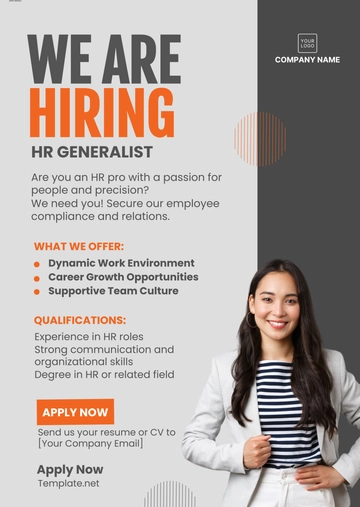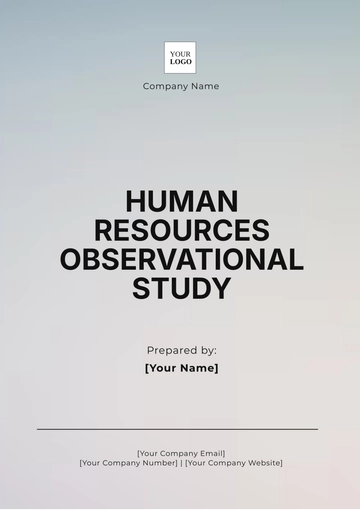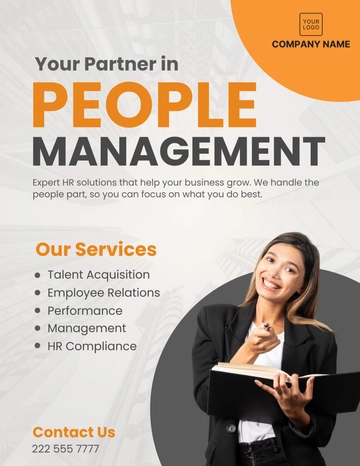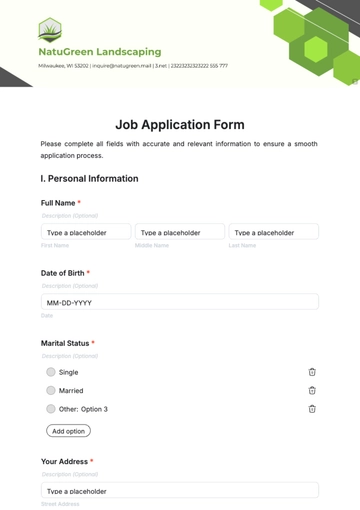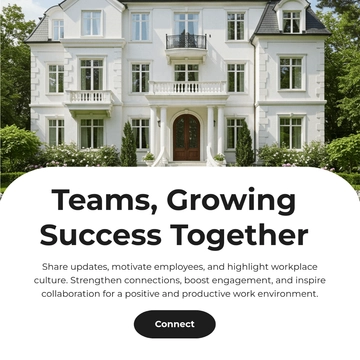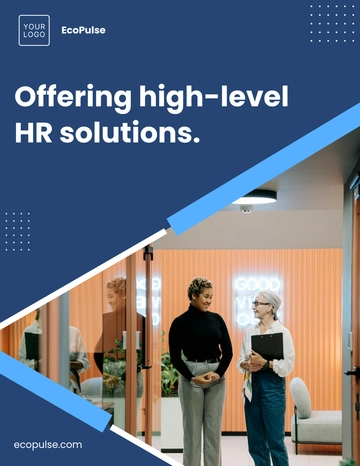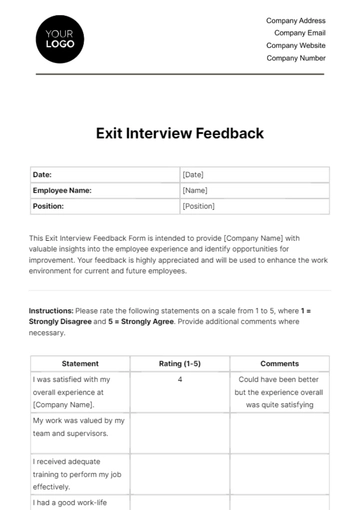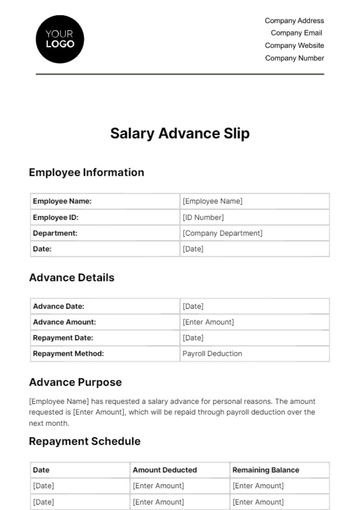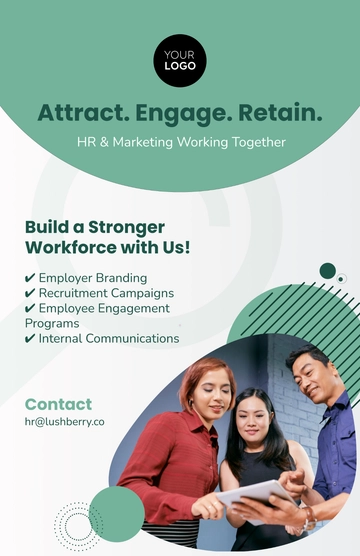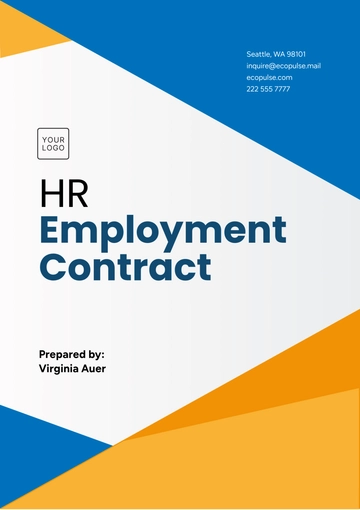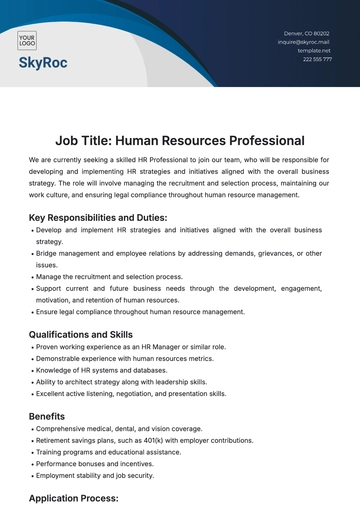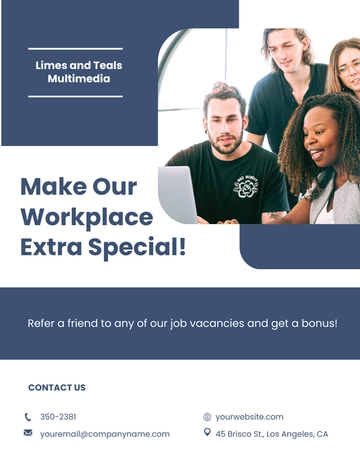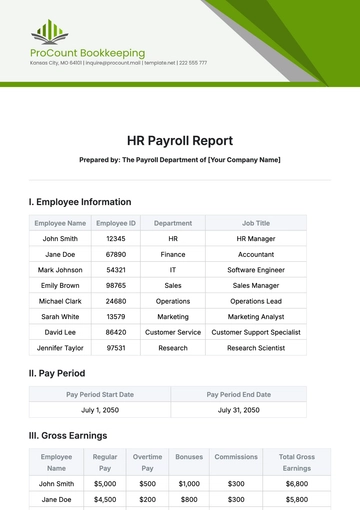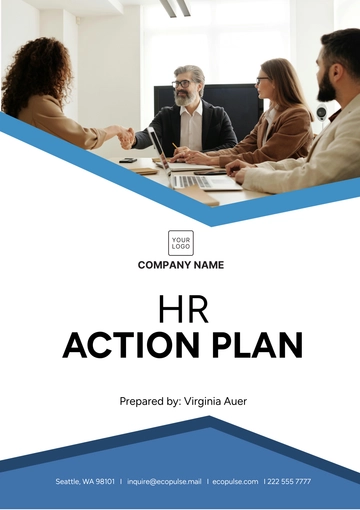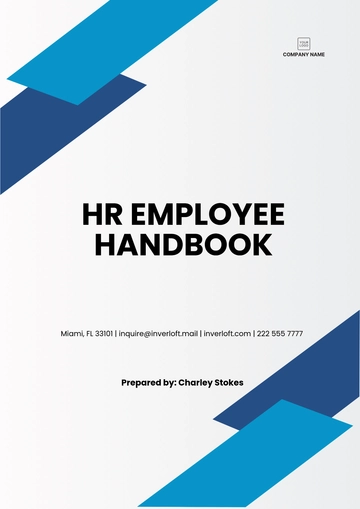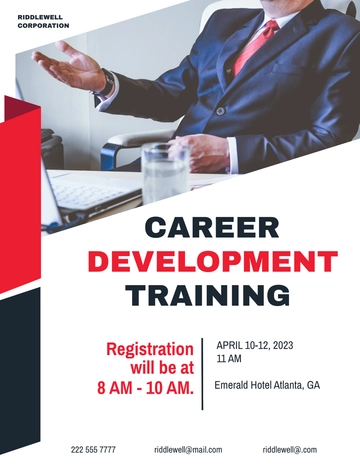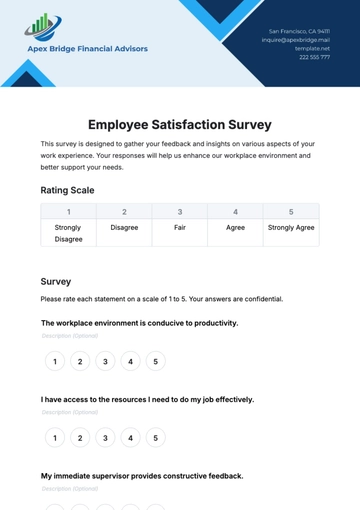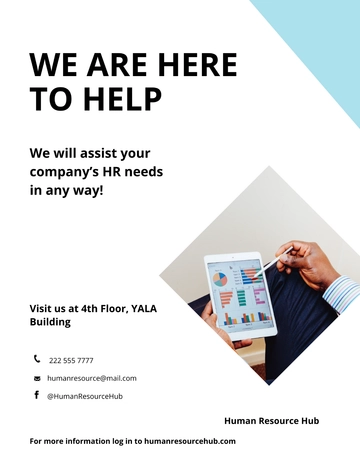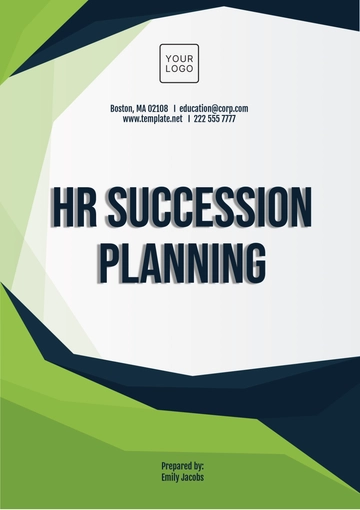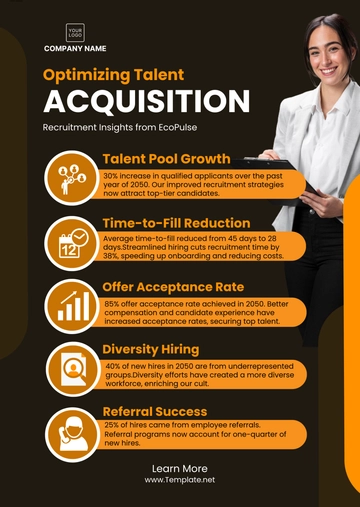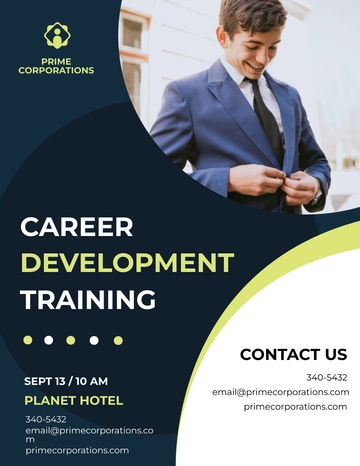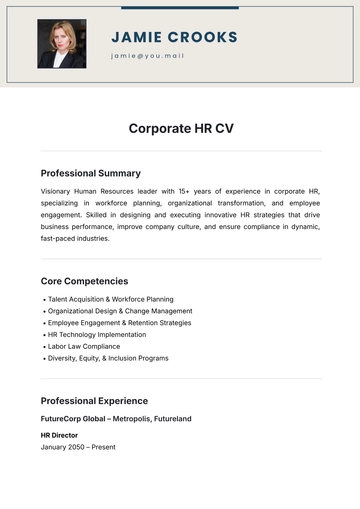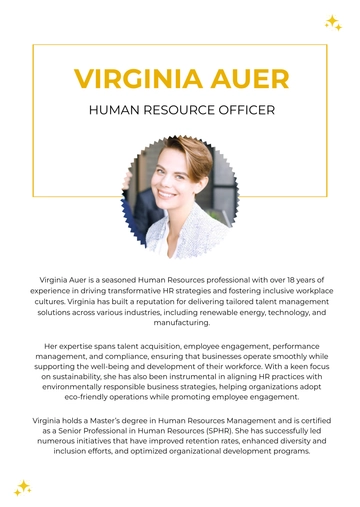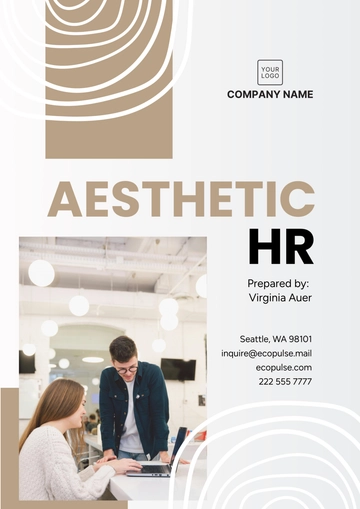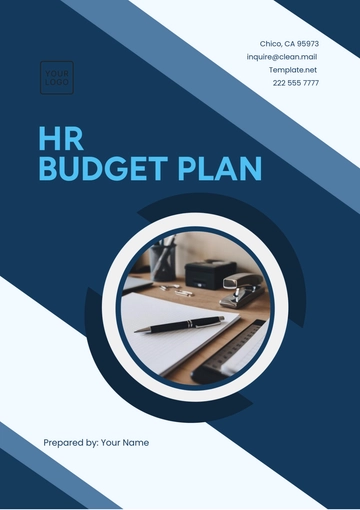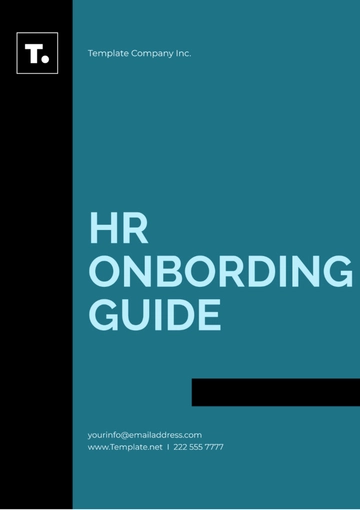Free Cafe HR Strategy
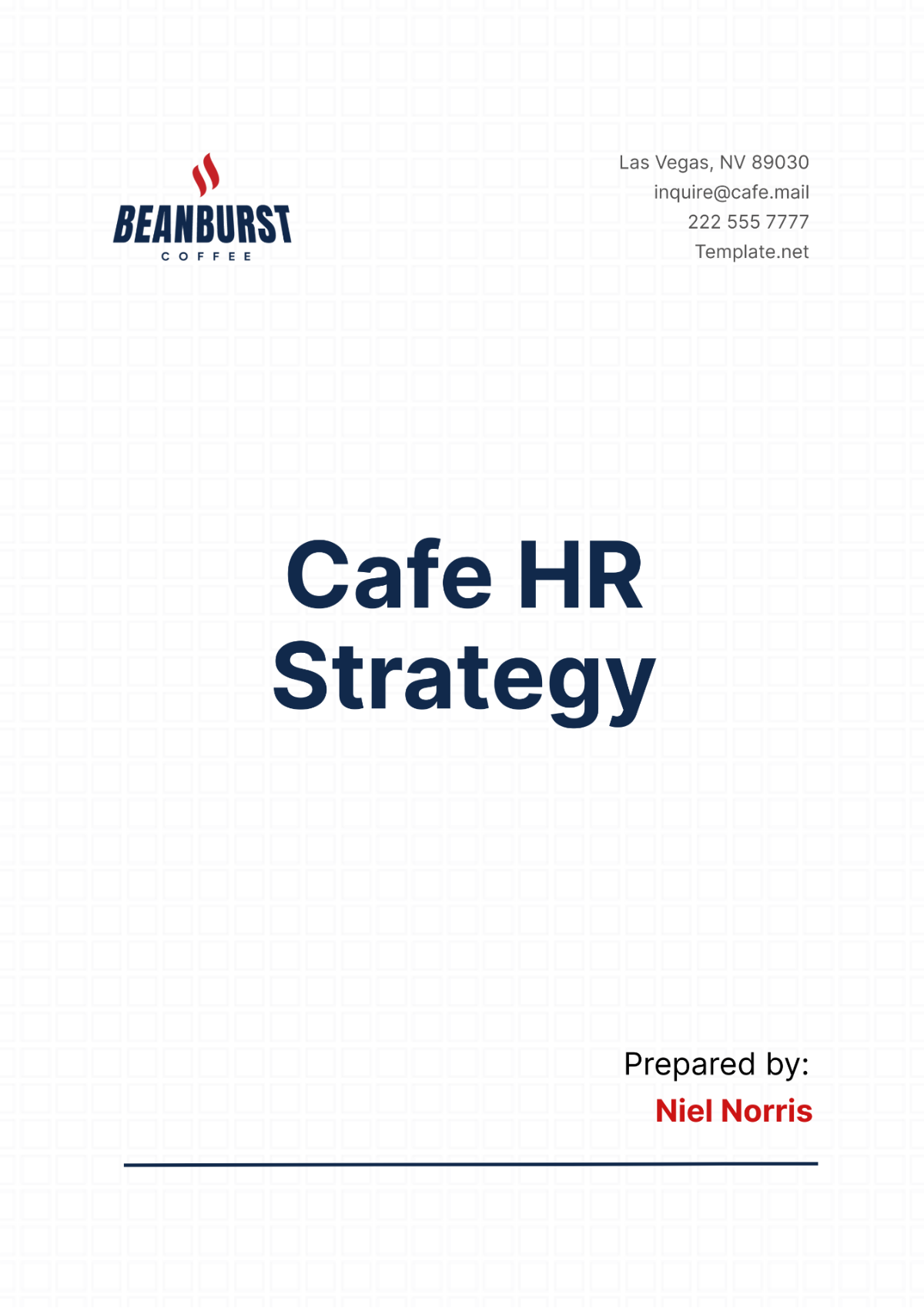
I. Executive Summary
This HR Strategy of [Your Company Name] aims to build a robust and dynamic workforce to drive our business forward in 2055. Our strategy focuses on attracting, developing, and retaining top talent to ensure we provide exceptional service and create a positive work environment. By implementing comprehensive training programs, fostering a supportive company culture, and offering competitive compensation and benefits, we aim to enhance employee satisfaction and productivity.
We plan to invest $500,000 in employee development programs, reflecting our commitment to continuous learning and growth. Additionally, our goal is to achieve a 90% employee retention rate by the end of 2055, emphasizing our focus on employee engagement and satisfaction. Our HR strategy also includes measures to enhance diversity and inclusion, ensuring a welcoming environment for all employees.
This document outlines our HR strategy in detail, covering recruitment, training and development, performance management, compensation, and benefits, as well as employee engagement and retention. By aligning our HR initiatives with our business goals, we aim to create a thriving workplace that supports both individual and organizational success.
II. Recruitment Strategy
A. Talent Acquisition
Job Fairs and Campus Recruitment: Participate in job fairs and collaborate with universities to attract fresh talent. These events allow us to connect with a diverse pool of candidates and promote our brand as an employer of choice.
Online Job Portals: Utilize online job portals to post vacancies and reach a broader audience. This approach increases our visibility and helps us attract candidates with various skills and experiences.
Social Media Recruiting: Leverage social media platforms to advertise job openings and engage with potential candidates. Social media recruiting helps us connect with a younger, tech-savvy audience.
Employee Referrals: Encourage current employees to refer qualified candidates for open positions. Employee referral programs often lead to higher quality hires and improved retention rates.
Recruitment Agencies: Partner with recruitment agencies to find specialized talent. Agencies have access to a wider network and can help fill niche roles efficiently.
B. Candidate Selection
Screening Resumes: Conduct initial resume screenings to identify candidates who meet the minimum qualifications for the position. This step ensures we only interview those who are a good fit for the role.
Structured Interviews: Implement structured interviews with standardized questions to evaluate candidates fairly and consistently. Structured interviews help us assess a candidate's skills, experience, and cultural fit.
Skills Assessments: Use skills assessments to test candidates' abilities and ensure they have the required competencies for the job. Skills assessments provide objective data to support our hiring decisions.
Background Checks: Perform background checks to verify candidates' employment history, education, and any potential red flags. Background checks help us make informed hiring decisions and maintain a safe workplace.
C. Diversity and Inclusion
Diversity Initiatives: Implement initiatives to attract a diverse workforce. Diverse teams bring varied perspectives and foster innovation.
Bias Training: Provide training to hiring managers to minimize biases during the recruitment process. Bias training promotes fair and equitable hiring practices.
Inclusive Job Descriptions: Write job descriptions that are inclusive and free of biased language. Inclusive descriptions attract a wider range of candidates.
Community Outreach: Engage with diverse communities and organizations to promote our job openings. Community outreach helps build a more inclusive candidate pool.
III. Training and Development
A. Onboarding Training
Orientation Sessions: Conduct comprehensive orientation sessions for new hires to introduce them to our company culture, values, and policies. Orientation helps new employees feel welcomed and informed.
Job-Specific Training: Provide training tailored to the specific roles and responsibilities of new employees. Job-specific training ensures new hires are well-prepared and confident in their roles.
Mentorship Programs: Pair new hires with experienced mentors who can offer guidance and support during their initial months. Mentorship programs facilitate smoother transitions and foster strong relationships.
Performance Evaluations: Conduct regular performance evaluations during the onboarding period to monitor progress and provide feedback. Evaluations help new hires develop their skills and adjust to their roles.
Cultural Assimilation: Include cultural assimilation training to help new employees understand and adapt to our company culture. This training fosters a sense of belonging and alignment with our values.
B. Continuous Learning
Workshops and Seminars: Offer workshops and seminars on relevant topics to enhance employees' skills and knowledge. These learning opportunities keep our staff up-to-date with industry trends and best practices.
E-Learning Platforms: Provide access to e-learning platforms with a wide range of courses. E-learning allows employees to learn at their own pace and convenience.
Cross-Training Programs: Implement cross-training programs to help employees acquire skills in different areas. Cross-training enhances flexibility and prepares staff for various roles within the company.
Tuition Reimbursement: Offer tuition reimbursement for employees pursuing further education. This benefit encourages continuous learning and personal development.
Leadership Development: Provide leadership development programs to prepare employees for management roles. Leadership training ensures a strong pipeline of future leaders.
C. Career Pathing
Career Mapping: Develop clear career maps outlining potential career paths within the company. Career mapping helps employees understand growth opportunities and plan their professional development.
Internal Promotions: Prioritize internal promotions to fill higher-level positions. Promoting from within boosts morale and demonstrates our commitment to employee growth.
Succession Planning: Implement succession planning to identify and prepare future leaders. Succession planning ensures business continuity and prepares us for leadership transitions.
Skill Gap Analysis: Conduct skill gap analyses to identify areas where additional training is needed. Addressing skill gaps helps maintain a competent and competitive workforce.
IV. Performance Management
A. Goal Setting
SMART Goals: Encourage employees to set SMART (Specific, Measurable, Achievable, Relevant, Time-bound) goals. SMART goals provide clear direction and enable employees to track their progress.
Regular Check-Ins: Schedule regular check-ins between employees and their managers to discuss goal progress and address any challenges. Regular check-ins ensure continuous support and alignment.
Performance Metrics: Use performance metrics to objectively measure employees' achievements and contributions. Metrics help identify high performers and areas needing improvement.
Feedback Mechanisms: Implement feedback mechanisms to provide employees with constructive feedback. Regular feedback fosters growth and helps employees improve their performance.
Goal Review Meetings: Hold bi-annual goal review meetings to assess progress and adjust goals as necessary. These meetings ensure goals remain relevant and attainable.
B. Performance Reviews
Annual Performance Reviews: Conduct annual performance reviews to evaluate employees' overall performance and set future goals. Annual reviews provide a comprehensive assessment of achievements and areas for development.
360-Degree Feedback: Use 360-degree feedback to gather input from peers, subordinates, and supervisors. This holistic approach provides a well-rounded view of an employee's performance.
Development Plans: Create personalized development plans based on performance review outcomes. Development plans outline specific actions to enhance skills and achieve career goals.
Recognition and Rewards: Recognize and reward high-performing employees for their contributions. Recognition programs boost morale and motivate employees to maintain high standards.
C. Continuous Feedback
Real-Time Feedback: Implement systems for providing real-time feedback to employees. Real-time feedback helps address issues promptly and reinforces positive behaviors.
Feedback Training: Train managers on how to give effective and constructive feedback. Proper feedback training ensures feedback is delivered in a supportive and beneficial manner.
Anonymous Feedback: Allow employees to provide anonymous feedback to management. Anonymous feedback helps identify issues that employees may be hesitant to raise openly.
Feedback Forums: Hold regular feedback forums where employees can discuss their concerns and suggestions. Feedback forums foster open communication and continuous improvement.
V. Compensation and Benefits
A. Competitive Salaries
Market Research: Conduct market research to ensure our salaries are competitive within the industry. Competitive salaries help attract and retain top talent.
Salary Reviews: Perform regular salary reviews to adjust compensation based on performance, market trends, and inflation. Salary reviews ensure fair and equitable pay.
Incentive Programs: Implement incentive programs to reward employees for exceptional performance. Incentives motivate staff to achieve their goals and contribute to the company's success.
Overtime Pay: Provide overtime pay for employees working beyond regular hours. Overtime compensation ensures employees are fairly compensated for their extra efforts.
Equity Adjustments: Make equity adjustments to address pay disparities and ensure all employees are compensated fairly. Equity adjustments promote fairness and equality.
B. Benefits Package
The following chart and table outline the benefits package we offer to our employees:
Benefit | Description | Cost Allocation |
|---|---|---|
Health Insurance | Comprehensive medical, dental, and vision coverage | $200,000 |
Retirement Plans | 401(k) plans with company matching contributions | $150,000 |
Paid Time Off | Generous vacation, sick leave, and holiday policies | $100,000 |
Employee Assistance Programs | Support for mental and emotional well-being | $50,000 |
Wellness Programs | Fitness memberships and wellness initiatives | $75,000 |
Total | $575,000 |
Health insurance is a cornerstone of our benefits package, with an annual allocation of $200,000. This comprehensive coverage includes medical, dental, and vision care, ensuring our employees' health and well-being are prioritized.
Retirement plans with company matching contributions are vital for long-term financial security. We allocate $150,000 annually to 401(k) plans, helping our employees save for the future.
Paid time off is essential for work-life balance. Our policies, with an annual cost of $100,000, provide generous vacation, sick leave, and holiday allowances, promoting rest and rejuvenation.
Employee assistance programs support mental and emotional well-being, with $50,000 allocated annually. These programs offer counseling and resources to help employees manage stress and personal challenges.
Wellness programs, with an annual budget of $75,000, include fitness memberships and wellness initiatives. These programs promote a healthy lifestyle and overall well-being.
Overall, our benefits package, totaling $575,000 annually, is designed to attract and retain top talent. By prioritizing health, financial security, and work-life balance, we demonstrate our commitment to employee well-being.
C. Work-Life Balance
Flexible Schedules: Offer flexible work schedules to accommodate employees' personal needs. Flexibility enhances job satisfaction and productivity.
Remote Work Options: Provide remote work options where feasible. Remote work offers convenience and helps maintain work-life balance.
Parental Leave: Implement parental leave policies to support employees during significant life events. Parental leave ensures employees can balance work and family responsibilities.
Employee Wellness: Promote employee wellness through programs and initiatives that encourage a healthy lifestyle. Wellness programs improve overall well-being and reduce stress.
Time-Off Policies: Develop time-off policies that allow employees to take breaks and recharge. Adequate time off helps prevent burnout and enhances job performance.
VI. Employee Engagement and Retention
A. Engagement Initiatives
Employee Surveys: Conduct regular employee surveys to gather feedback on job satisfaction and engagement levels. Surveys help identify areas for improvement and address employee concerns.
Team Building Activities: Organize team building activities to foster collaboration and camaraderie. Team building strengthens relationships and enhances team performance.
Recognition Programs: Implement recognition programs to celebrate employees' achievements and contributions. Recognition boosts morale and motivates employees to excel.
Open Communication: Promote open communication between management and staff. Open communication ensures employees feel heard and valued.
Career Development: Provide opportunities for career development and growth. Career development initiatives enhance engagement and loyalty.
B. Retention Strategies
The following table outlines our retention strategies and their annual costs:
Strategy | Description | Cost Allocation |
|---|---|---|
Competitive Salaries | Ensuring market-aligned pay to retain talent | $500,000 |
Professional Development | Continuous learning and growth opportunities | $200,000 |
Employee Recognition | Programs to recognize and reward employees | $100,000 |
Work-Life Balance Initiatives | Policies promoting balance between work and personal life | $150,000 |
Total | $950,000 |
Competitive salaries are crucial for retention, with an annual allocation of $500,000. Ensuring our pay is market-aligned helps retain top talent and reduce turnover.
Professional development, with a $200,000 annual budget, offers continuous learning and growth opportunities. Investing in development demonstrates our commitment to employees' careers.
Employee recognition programs, costing $100,000 annually, celebrate achievements and contributions. Recognition boosts morale and encourages employees to remain with the company.
Work-life balance initiatives, with an annual cost of $150,000, promote a healthy balance between work and personal life. These policies enhance job satisfaction and reduce burnout.
Overall, our retention strategies, totaling $950,000 annually, focus on competitive compensation, professional growth, recognition, and work-life balance. These elements are key to maintaining a satisfied and loyal workforce.
C. Employee Wellness
Health Programs: Implement health programs to support employees' physical well-being. Health programs reduce absenteeism and increase productivity.
Mental Health Support: Offer mental health support through counseling and wellness initiatives. Mental health support ensures employees have the resources to manage stress and mental health challenges.
Fitness Initiatives: Encourage fitness through gym memberships and fitness classes. Fitness initiatives promote a healthy lifestyle and improve overall well-being.
Nutritional Support: Provide nutritional support through healthy meal options and nutrition education. Nutritional support helps employees make healthier choices and improves energy levels.
VII. Training Budget
The following chart and table outline our training budget and its allocation across different training programs:
Training Program | Description | Cost Allocation (Annual) |
|---|---|---|
Onboarding Training | Training for new hires to integrate into the company | $150,000 |
Continuous Learning | Workshops, seminars, and e-learning platforms | $100,000 |
Leadership Development | Programs to develop future leaders | $75,000 |
Technical Skills Training | Training for specific technical skills | $50,000 |
Health and Safety Training | Training to ensure workplace safety and compliance | $25,000 |
Total | $400,000 |
Onboarding training, with an annual budget of $150,000, is essential for integrating new hires into the company. This training ensures new employees are well-prepared and aligned with our culture.
Continuous learning, with a $100,000 budget, includes workshops, seminars, and e-learning platforms. These programs keep our employees' skills and knowledge up-to-date.
Leadership development programs, costing $75,000 annually, prepare employees for future management roles. Investing in leadership development ensures a strong pipeline of future leaders.
Technical skills training, with a $50,000 allocation, provides specialized training for specific roles. Technical skills training enhances job performance and efficiency.
Health and safety training, with a $25,000 budget, ensures compliance with workplace safety regulations. This training minimizes workplace accidents and legal risks.
Overall, our training budget of $400,000 supports comprehensive development programs. These investments in employee development are crucial for maintaining a skilled and competent workforce.
VIII. Training Evaluation
A. Methods of Evaluation
Surveys and Feedback Forms: Distribute surveys and feedback forms to gather participants' opinions on training programs. These tools provide valuable insights into the effectiveness and areas for improvement.
Performance Metrics: Use performance metrics to measure the impact of training on employees' job performance. Metrics such as productivity, accuracy, and customer satisfaction help assess the training's effectiveness.
Observations: Conduct observations to evaluate how employees apply new skills in their work. Observations provide real-time data on training effectiveness and identify areas needing reinforcement.
Competency Assessments: Implement competency assessments to measure employees' knowledge and skills before and after training. Assessments help quantify the learning gains and identify areas for further development.
B. Impact Analysis
Employee Satisfaction: Assess the impact of training on employee satisfaction and engagement. Satisfied employees are more likely to remain with the company and contribute positively.
Client Feedback: Analyze client feedback to gauge the impact of training on service quality. Positive feedback indicates successful training outcomes and improved client experiences.
Financial Performance: Evaluate the correlation between training programs and financial performance. Increased revenue and reduced costs reflect the positive impact of training on business outcomes.
Turnover Rates: Monitor employee turnover rates to determine the impact of training on retention. Lower turnover rates indicate effective training and a supportive work environment.
C. Continuous Improvement
Feedback Loop: Establish a feedback loop to continuously gather and analyze data on training effectiveness. A feedback loop ensures ongoing improvements and adaptation to changing needs.
Review and Update: Regularly review and update training programs based on feedback and performance data. Continuous updates ensure training remains relevant and effective.
Best Practices: Identify and implement best practices from within the industry and our own experiences. Best practices enhance the quality and impact of training programs.
Long-Term Planning: Develop long-term plans for training and development to support strategic business goals. Long-term planning ensures a consistent focus on employee growth and development.
IX. Conclusion and Next Steps
A. Conclusion
Our Cafe HR Strategy for 2055 is designed to build a strong, motivated, and skilled workforce that drives our business success. By focusing on comprehensive recruitment, training, performance management, compensation, and employee engagement initiatives, we aim to create a positive and productive work environment. Our investment in employee development, supported by a robust evaluation process, ensures continuous improvement and alignment with our business goals.
Creating a thriving workplace is essential for attracting and retaining top talent. Our HR strategy reflects our commitment to employee satisfaction, diversity, and inclusion. By fostering a supportive company culture and offering competitive benefits, we aim to be an employer of choice in the industry.
B. Next Steps
To implement our HR strategy effectively, we will undertake the following next steps:
Launch Recruitment Campaigns: Initiate targeted recruitment campaigns to attract diverse and talented candidates. These campaigns will highlight our inclusive work environment and growth opportunities.
Develop Training Programs: Design and schedule comprehensive training programs aligned with our strategic goals. These programs will focus on onboarding, continuous learning, and leadership development.
Implement Performance Management: Roll out performance management systems to set goals, provide feedback, and evaluate employee performance. Performance management will ensure alignment with our business objectives.
Review Compensation and Benefits: Conduct market research and reviews to ensure our compensation and benefits packages remain competitive. This step is crucial for attracting and retaining top talent.
Enhance Employee Engagement: Launch initiatives to improve communication, team building, and recognition within the workplace. Engaging employees through various programs will boost morale and productivity.
By executing these steps, we will lay a strong foundation for a successful HR strategy. Our commitment to continuous improvement and alignment with business goals will ensure sustained growth and employee satisfaction.
- 100% Customizable, free editor
- Access 1 Million+ Templates, photo’s & graphics
- Download or share as a template
- Click and replace photos, graphics, text, backgrounds
- Resize, crop, AI write & more
- Access advanced editor
Develop effective HR strategies with ease with our Cafe HR Strategy Template! Available only here on Template.net, this customizable template offers a comprehensive framework for HR planning. Its editable format allows for easy adjustments to suit specific goals. Utilize the AI Editor Tool for efficient drafting and strategic alignment immediately!
